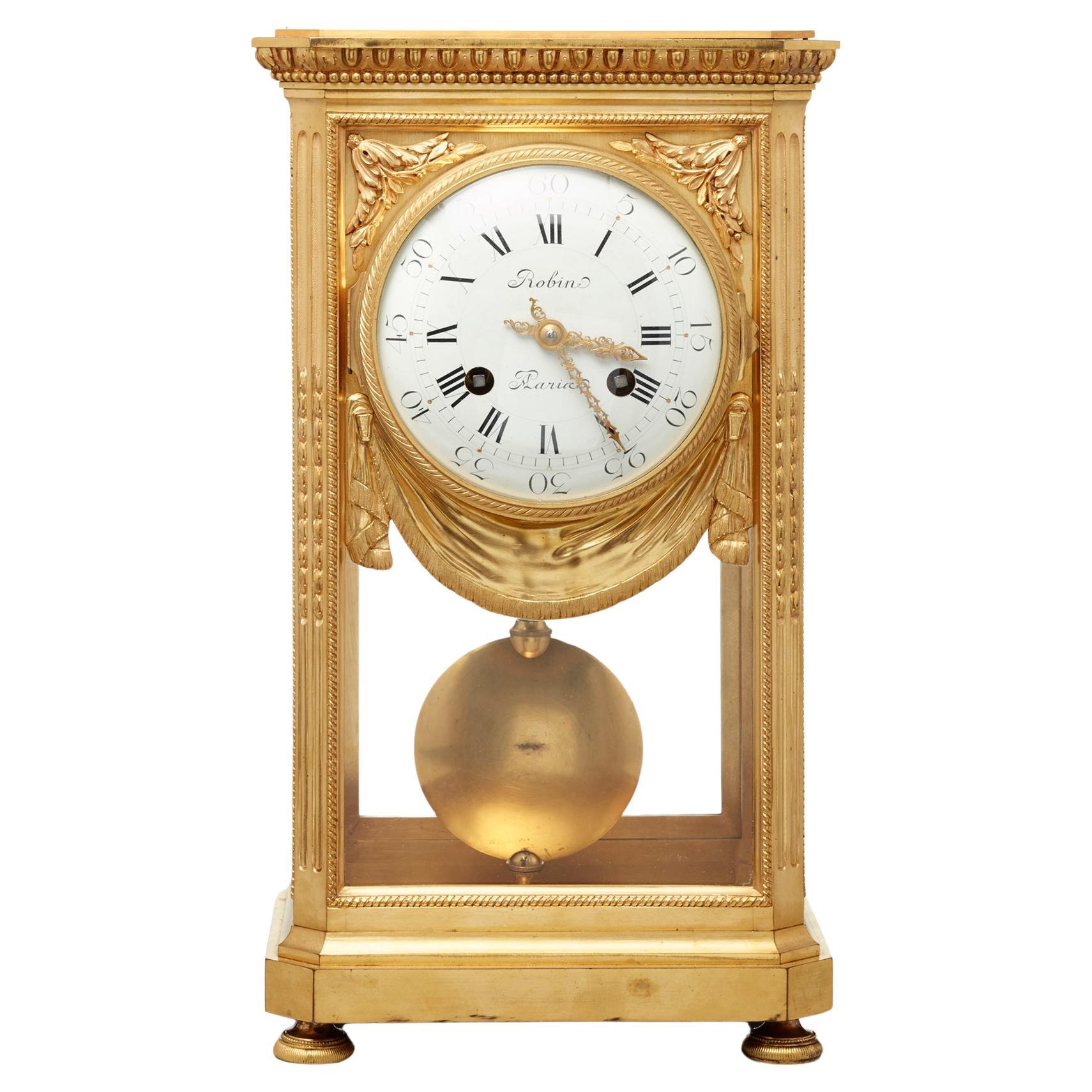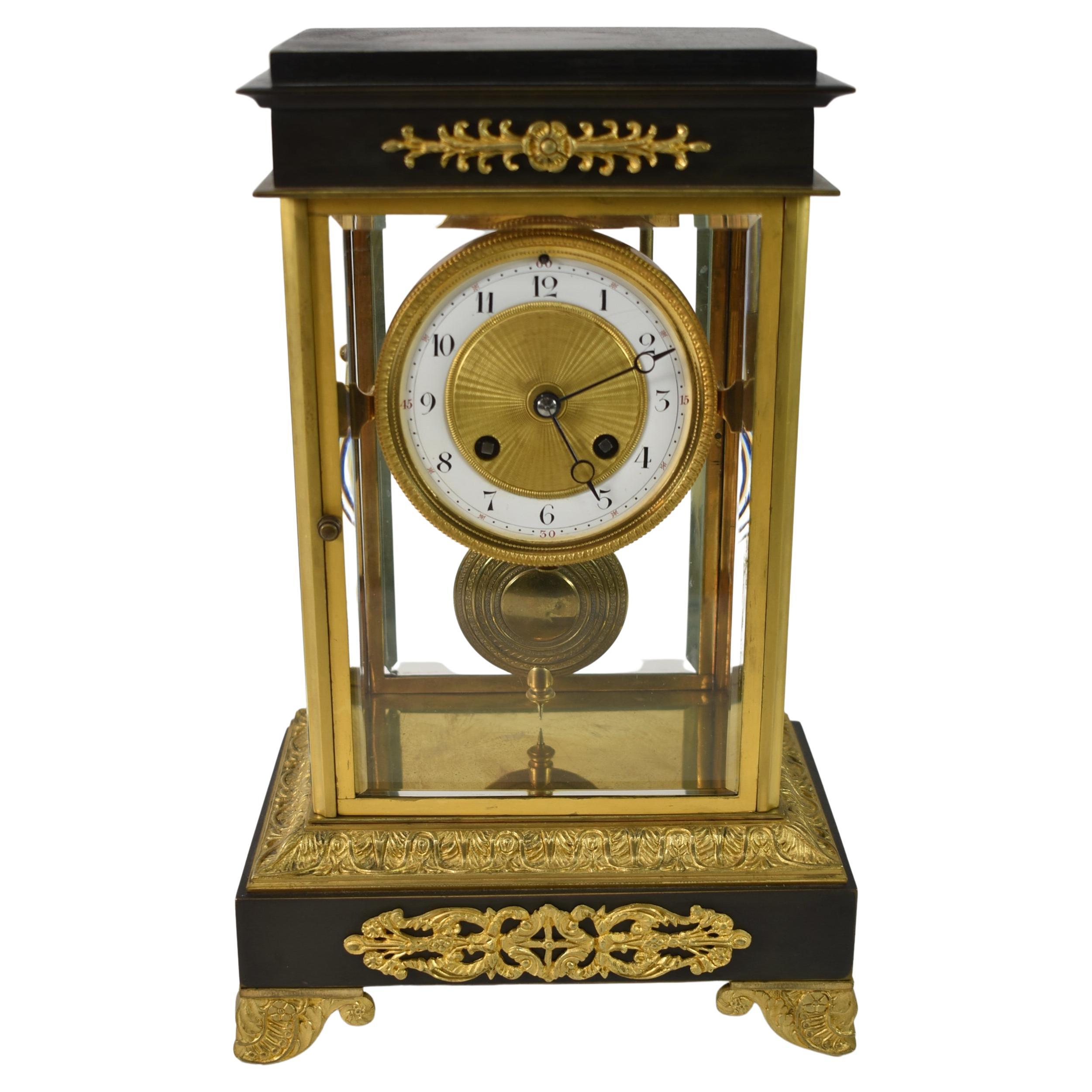Items Similar to Regulator by French Royal Exchange
Want more images or videos?
Request additional images or videos from the seller
1 of 7
Regulator by French Royal Exchange
About the Item
A very fine regulator made by the firm of French Royal Exchange, the eight day movement with Harrison’s maintaining power and deadbeat escapement, is beautifully made with turned doric pillars and water of air patterned front and back plates. The pendulum has a wooden rod that has been gilded, to prevent expansion for precision timekeeping with a brass bound weight. The silvered observatory dial is crisply engraved with blued steel hands and numbered 972. The restrained mahogany case is in excellent condition with an arched top that has an access panel at the top.
In 1839 John Moore French, his sons John and William French established the firm known as 'The City Observatory' which was located at Cornhill in the City of London. They operated a Standard Time Ball controlled by a telegraph signal from Greenwich and specialized in the making of chronometers. They were in business at 9 Royal Exchange until 1875, examples of their work can be found in the Royal Collections.
The firm of French Royal Exchange were a renowned family of watch and chronometer makers who occasionally made long case clocks the were established in 1810, this clock dates from the 1850’s.
- Creator:French Royal Exchange London (Clockmaker)
- Dimensions:Height: 79.14 in (201 cm)Width: 22.05 in (56 cm)Depth: 13 in (33 cm)
- Style:Victorian (Of the Period)
- Materials and Techniques:
- Place of Origin:
- Period:
- Date of Manufacture:circa 1850
- Condition:Wear consistent with age and use.
- Seller Location:Amersham, GB
- Reference Number:
About the Seller
No Reviews Yet
Vetted Seller
These experienced sellers undergo a comprehensive evaluation by our team of in-house experts.
1stDibs seller since 2023
- ShippingRetrieving quote...Ships From: Amersham, United Kingdom
- Return PolicyA return for this item may be initiated within 14 days of delivery.
More From This SellerView All
- Art Deco 1930's RegulatorLocated in Amersham, GBA very fine regulator dating from 1936 in a restrained art deco style. The large precision 8 day movement with Harrison’s maintaining power, and a dead beat escapement with six bar wheels...Category
Vintage 1930s Scottish Art Deco Grandfather Clocks and Longcase Clocks
MaterialsBrass, Steel
- A Miniature Two Train Vienna RegulatorLocated in Amersham, GBA rare wedge shaped laterndluhr Vienna regulator with a two train weight driven movement of exceptional quality. The eight day movement strikes the ho...Category
Antique 1830s Hungarian Biedermeier Wall Clocks
MaterialsBrass, Steel
- A Twin Fusee Bracket Clock By DentBy DentLocated in Amersham, GBA striking two train bracket clock of exceptional quality by one of the great nineteenth century makers. The eight day twin fusee movement strikes on a blued steel gong behind a silvered arabic dial, signed Dent and numbered 58242 on both th dial and the back plate. Housed in a solid mahogany case with brass mounts and a gadrooned pergoda top surmounted by an acorn finial, and supported by bun feet. The sides ar pierced with attractive fish scale sound vents lined with dark blue velvet. The movement and case are both of remarkable quality, as you would expect from a clock made by Dent. The history of Dent & Co. spans three centuries of precision watch and clock making in Great Britain. Established in 1814 by Edward J. Dent, the company embraced the Victorian fervour for technological innovation and created precision chronometers to navigate the Royal Navy and guide some of the most intrepid explorers on their voyages. The British Empire was in full expansion and its maritime tradition had produced some remarkable technological breakthroughs from the late 18th century. Propelling the impetus of Britain’s primacy, Dent proved a key player in Victorian horological history manufacturing the Standard Clock at the Royal Observatory, Greenwich which was to keep “Greenwich Mean Time” the time to which all others in the Empire were referred (better known today as G.M.T.) and continued to do so until replaced by an electronic clock in 1946. Dent also made probably the most famous clock in the world - the Great Clock for the Houses of Parliament, familiarly known as Big Ben. Dent’s reputation soared and their chronometers accompanied some of the century's most influential and colourful explorers. Dent chronometer...Category
Antique Early 1900s English High Victorian Mantel Clocks
MaterialsBrass, Steel
- A Miniature Skeleton Alarm Clock by Victor Athanase PierretBy Victor Athanase PierretLocated in Amersham, GBA miniature French skeleton alarm clock with silk suspension dating from the mid 19th century, with original glass dome on an ebonised and brass inlaye...Category
Antique 1850s French Victorian Mantel Clocks
MaterialsBrass, Steel
- Twin Fusee Bracket Clock By Barraud And LundLocated in Amersham, GBA striking drum head bracket clock by Barraud and Lund of exceptional quality. The case is made of quarter sawn mahogany with a beautifully crisp silv...Category
Antique Mid-19th Century English Victorian Mantel Clocks
MaterialsBrass
- 19th Century Burr Walnut Bracket Clock by LenzkirchBy LenzkirchLocated in Amersham, GBA quarter striking bracket clock in a fine figured burr walnut case with ormolu mounts and sound frets backed in sage green silk. A gilded dial with silvered chapter ring, roman nume...Category
Antique 1890s German Late Victorian Mantel Clocks
MaterialsBrass, Steel, Ormolu
You May Also Like
- Late William IV Rosewood Bracket Clock by French, Royal Exchange, LondonLocated in Lymington, HampshireThe case carved in high relief with scrolls and an acanthus leaf finial, the gilt face finely chased with further scrolls and signed on the dial, with a discreet/silent lever above t...Category
Antique 1830s English Mantel Clocks
MaterialsRosewood
- French table regulator by Henri RobertLocated in HAARLEM, NLAs a former pupil of Abraham Louis Brequet (one of the most important clockmaker of that time, who invented a lot of experimental and difficult escapements), Henri Robert...Category
Antique 19th Century French Mantel Clocks
MaterialsWalnut
- French mahogany regulator 'portico' mantel clock by MontassierLocated in HAARLEM, NLThe clock movement is suspended from a portico within four pillars. The mahogany case is decorated with extremely beautiful cast and gilded bronzes, including two griffons facing an ...Category
Antique 19th Century French Empire Mantel Clocks
MaterialsBronze
- French bronze 'four glass' table regulator by RobinLocated in HAARLEM, NLA good very fine bronze gilded 19th century table regulator signed Robin a Paris A fine ‘four glass’ table regulator, striking on bel with countwheel with a three week running move...Category
Antique 19th Century European Mantel Clocks
MaterialsBronze
- Antique French Empire Crystal Regulator ClockLocated in Toledo, OHA beautiful brass clock with gold dore finish. Beveled glass panels with a porcelain dial and time and strike. French works. Running condition. Corner crack in one glass panel.Category
20th Century European Empire Mantel Clocks
MaterialsBrass
- James Condliff Skeleton Table Regulator ClockLocated in New Orleans, LAA horologic masterpiece of precision and beauty, this Victorian-era skeleton clock is an extraordinary example of 19th-century British clockmaking by the famed James Condliff of Liverpool. Regarded as the father of the English skeleton clock...Category
Antique 19th Century English Victorian Mantel Clocks
MaterialsBrass
Recently Viewed
View AllMore Ways To Browse
Rhythm Quartz Clock
American Can Company Oyster Case
Hamilton Grandfather Clock
Oak Longcase Clocks 18 Century
Thomas Moore Long Case Clock
Tide Clock
Antique Granfather Clock
Barwick Grandfather Clock
Eccles Grandfather Clock
Howard Miller Burl Wood Grandfather Clock
Mission Grandfather Clock
Skelton Clock
French Mobier Clock
Haga H Fors
Hortons Antique Clocks
Tiger Maple Clock
Green Mora Clock
Antique German Grandfather Clocks





